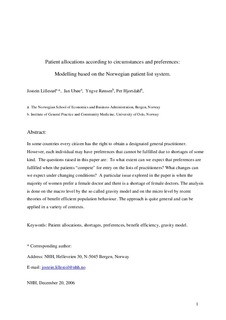| dc.contributor.author | Lillestøl, Jostein | |
| dc.contributor.author | Ubøe, Jan | |
| dc.contributor.author | Rønsen, Yngve | |
| dc.contributor.author | Hjortdahl, Per | |
| dc.date.accessioned | 2007-06-20T12:09:14Z | |
| dc.date.available | 2007-06-20T12:09:14Z | |
| dc.date.issued | 2006-12 | |
| dc.identifier.issn | 1500-4066 | |
| dc.identifier.uri | http://hdl.handle.net/11250/163889 | |
| dc.description.abstract | In some countries every citizen has the right to obtain a designated general practitioner. However, each individual may have preferences that cannot be fulfilled due to shortages of some kind. The questions raised in this paper are: To what extent can we expect that preferences are fulfilled when the patients “compete” for entry on the lists of practitioners? What changes can we expect under changing conditions? A particular issue explored in the paper is when the majority of women prefer a female doctor and there is a shortage of female doctors. The analysis is done on the macro level by the so called gravity model and on the micro level by recent theories of benefit efficient population behaviour. The approach is quite general and can be applied in a variety of contexts. | en |
| dc.language.iso | eng | en |
| dc.publisher | Norwegian School of Economics and Business Administration. Department of Finance and Management Science | en |
| dc.relation.ispartofseries | Discussion paper | en |
| dc.relation.ispartofseries | 2007:2 | en |
| dc.subject | Patient allocations | en |
| dc.subject | shortages | en |
| dc.subject | preferences | en |
| dc.subject | benefit efficiency | en |
| dc.subject | gravity model | en |
| dc.title | Patient allocations according to circumstances and preferences: Modelling based on the Norwegian patient list system | en |
| dc.type | Working paper | en |
| dc.subject.nsi | VDP::Samfunnsvitenskap: 200::Økonomi: 210::Bedriftsøkonomi: 213 | en |
